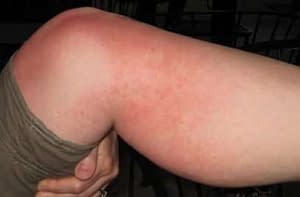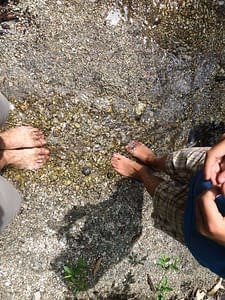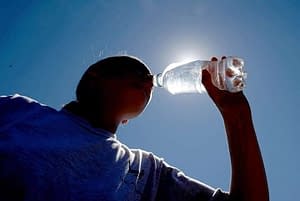Adventure School participates in the Amazon Services LLC Associates Program, an affiliate advertising program for sites to earn advertising fees by advertising and linking to amazon.com
Heatstroke has a mortality rate of up to 71%. You have better odds of surviving a lightning strike (10% mortality rate)! Heatstroke kills an average of 334 people each year. This post is meant to help you learn to prevent heat-related illnesses, recognize the signs and symptoms of hyperthermia and heat stroke, and treat them when they occur.
Heatstroke isn’t the only heat-related illness, but it’s definitely the most serious one.
Watch this video to learn about heatstroke.
What are the various heat-related illnesses?
Anytime you get out in the heat, you can start to feel uncomfortable and develop heat-related symptoms. The most common are heat rashes. Heat exhaustion, dehydration, and heat stroke are more serious, but not as common.
Heat Rash
Heat rash happens most frequently to children and individuals with sensitive skin in hot and humid weather. It’s just what it sounds like – an itchy, prickly rash that forms when you sweat in hot weather. Almost all heat rash will resolve once you cool off. It’s uncomfortable, but nothing to worry about.

Dehydration
Although dehydration isn’t directly caused by the heat, it frequently accompanies hot weather. Dehydration happens when your body runs out of water. This can happen any time, but when you’re out in the sun sweating up a storm, dehydration isn’t far behind unless you’re drinking plenty of water.

Heat Exhaustion
Heat exhaustion is a bit more serious than heat cramps or a heat rash, but still a common and non-life-threatening situation. If untreated, it can quickly turn to heatstroke which is often fatal. Heat exhaustion happens when in high heat, high humidity, and often happens during exertion. As the body heats up, starts sweating, and as the heart starts pounding, you quickly wear yourself out.
The symptoms of heat exhaustion can be:
- goosebumps and cold skin when in hot weather
- profuse sweating
- headache
- fatigue
- dizziness
- nausea
- rapid, but weak pulse
- orthostatic hypotension
- Cramping
Many of these symptoms also show up in heatstroke, so knowing the difference is critical. Keep reading to learn… 🙂
If someone is suffering from heat exhaustion, the best treatment is to cool them off and let them rest. Get them out of the sun, give them some ice water and let them cool off. Once they begin feeling better, they can continue, but cautiously.
If you don’t catch heat exhaustion soon enough, it can become heatstroke so best pay attention to yourself and all others in your group. Stay alert and ask people how they feel and watch for any of the signs and symptoms.
Heatstroke
Okay, we made it to the big bad heatstroke. It’s not always easy to identify, so study up and be prepared.
What is heatstroke?
At its most basic, heatstroke is when your body overheats – like when a car overheats. There are two types of heatstroke:
Exertional heatstroke
Exertional heat stroke happens during exercise or heavy activity. It’s most common in active (that’s all of you) people playing out in the sun.
Non-exertional heatstroke
Non-exertional heatstroke happens at rest. It’s most common in elderly people during heat waves or children/pets who get stuck in hot places.
Other than having the person exerting themselves stop exerting, the two are essentially the same so I’ll put them together under just heatstroke for the rest of the article.
So back to what heatstroke is:
As I said, you get heatstroke when you overheat. Your body has several ways to cool itself off:
How do we cool off?

Convection – Heat transfer from a surface to the surrounding air using air currents. An example of this is your ceiling fan. As air runs across your skin, heat is transferred off you and into the moving air.
Evaporation – Heat transfer during conversion of a liquid (sweat) to a vapor. An example of this is your swamp cooler. Heat is transferred to water as it changes states.
Conduction – Heat transfer from a solid to a solid through direct contact. An example of this is sitting on a cool rock. You transfer heat to the rock as long as it’s colder than you.
Radiation – Heat transfer from a hot to a colder object not in direct contact with it. An example of this is the sun’s rays. This isn’t you transferring heat out, but the same thing happens to objects around you on a much smaller scale.
All these heat transfer processes are at play when you’re hot, but the most significant is evaporation followed by convection. That’s what you feel on a hot day when you’re all sweaty and the wind blows. It feels great! You cool off, you go about your day – but if your body temperature gets too high and your cooling systems can’t deal with the heat, you get heatstroke. The definition of heatstroke is that your core temperature rises above 99.5°F (37.5°C).
Note that heatstroke is different than a fever. A fever happens when your body temperature is raised by your internal thermostat – your hypothalamus – to a higher set point. Heatstroke is when the thermostat stays at the same setpoint, but it’s hot nonetheless.

How do you prevent heatstroke
So if you’re like me, you want all the adventure without worrying about the weather. I want to hike, bike, and climb even when it’s hotter than Hades out there. How do you go about your adventure when it’s hot without getting heatstroke? Read on my friend.
Plan around the heat
The most important piece of the puzzle starts before you get out in the heat. Plan to beat the heat before your trip. If you know you’ll be doing something outside when it’s too hot for comfort, figure out what you can do to mitigate the heat.

Can you start early in the morning or go late after the sun sets? Ever try biking in the dark?
-
 Water Filtration System$18.44
Water Filtration System$18.44
Can you pick a venue with a shady exposure or one that’s near water where you can cool off easily?
Do you need to bring extra water and cooler clothes and shoes to make it bearable? Do you need a water filter to resupply on water if you run out?
I like to hydrate super well before heading out into the heat by drinking extra the night before an adventure.
Here’s the water filter I carry with me. It’s small and light and easy to pack in my emergency kit.
Dress for the heat
Once you make your plans, dress for success! What do you wear in hot weather to stay cooler? This will largely depend on what your activities are, but lightweight, light-colored and airy clothing is best. Getting long-sleeved shirts and pants with UV protection will also keep you safe from sunburn.
Shirts like these and pants like these are ideal for hot days
Of course you can wear short-sleeve clothes too, and they’ll help you stay cool, but then you have to worry about sun protection.
The most important element of how you dress is that you wear lightweight and breathable materials. Shoes, socks, hat, backpack – they should all be designed to breathe and allow air circulation. Remember – convection and evaporation are the best ways to cool off. Let the airflow and the water dry out! This means wear wool socks. Read all about my sock opinions in this post.
Don’t wear cotton! wear a technical fabric or wool.
Acclimatization
This topic is one I firmly believe in but don’t see tons written about it. If you spend a bunch of time out in the heat, your body gets used to the heat and adapts accordingly. You’ll get more efficient at cooling off and be better at staying out for longer periods in hotter weather. I lived in the Philippines for two years where it’s always 90 degrees and 90+ percent humidity. It was hot! I spent my days walking around in big heavy shoes but I got used to it.
When I came home to Utah in July, I was freezing cold in the mornings when it was 65 degrees. My body had acclimated to the heat and humidity and wasn’t used to the cold – if you can call 65 cold.
Before you go out into the wilderness in the summertime, acclimate yourself by spending some good days working in the yard when it’s hot or playing where it’s safe close to home. That way you’ll be ready for the heat when you get way out there in the backcountry and won’t need SAR.
While you’re in the heat of the day
So you’ve done all you can to avoid getting heatstroke before your adventure, but you still find yourself out in the heat. What can you do to avoid overheating?
Stay in the shade as much as you can. Hike on the shady side of the canyon or trail if you can. Take breaks in shady spots.
Cool off in water when you have the chance. I love to dip my hat or my whole head in water. It’s fresher than sweat and works better since it’s cold. It will absorb more heat. In some places, especially when canyoneering, I’ll even jump in the water with all my clothes on to cool off my core temp.

Drink plenty of water. Although dehydration and heatstroke are different beasts, you’re more likely to get heatstroke if you’re dehydrated just like your car will overheat without coolant.
Pay attention to your body. If you start to get too hot, take a break. Take your shoes and socks off and rest until you’re cool enough to proceed. Better late than dead.
What are the signs and symptoms of heatstroke?
So how do you know if you’re just hot and need to buck up or if you’re going to keel over dead from heatstroke?
Heat exhaustion can cause many of the same symptoms as heatstroke, so knowing the difference is important to reacting to both properly.
Heatstroke is typically accompanied by these signs and symptoms:
- Headache
- Confusion and altered mental state
- Dizziness
- Nausea or vomiting
- Weakness and fatigue
- Low blood pressure
- swelling extremities and face

It will always be accompanied by an elevated core body temperature. This one is key to telling it apart from other issues, but only if you really take the core temperature. When you’re out working hard in the sun, your skin will get hot so taking a forehead temp isn’t going to be a true core temp. The only way to get the real core temp is by …
… a rectal temperature! Yep, to really know for sure, you’ll have to probe.
If their core temp is above 99.5°F (37.5°C), you need to act quickly to cool them off!
How do you treat heatstroke?
So it should be pretty obvious that treating heatstroke is done by removing the excess heat from a person, but how do you do that when you’re out on the trail and it’s sweltering hot out?
The best method is using water. It’s almost always cool and may be very cold. Water is a great conductor of heat and will very quickly suck excess heat out of a person. If you’re lucky enough to have a river, lake, pond, or stream around, stick the person in the water in a comfortable sitting or lying position that they’ll be safe from drowning in – preferably in the shade.
If no water is nearby, find a shady spot to lay them down and use whatever water you have to wet their clothes and skin in soft-tissue areas like the inside of the elbows and knees, the neck, and ears. Take their shoes and socks off and elevate their feet slightly. If you don’t have much water left, it may not be wise to pour it on someone just to end up dehydrated. If this is the situation, use a shirt to fan the person to increase the convection heat loss and improve evaporative cooling.
If a person suffering from heatstroke can’t cool off on their own in the field, you need to get them help through 911. It’s all too easy to think things will be fine. Don’t assume this will work out. Get the person help quickly if you can’t cool them off.
If you can cool them off enough, rest up, wait until things are cooler out, and proceed back to safety on your own. A person that’s been in heatstroke is severely stressed already so don’t try to push through to the peak or whatever the objective of the day is. Call it a day and try again next time.
Final thoughts
Heatstroke kills. Don’t let it kill you! Be smart, have fun, and be safe.
If you’ve got any experiences with heat stroke or other heat-related illnesses, we’d love to hear about them in the comments below.








